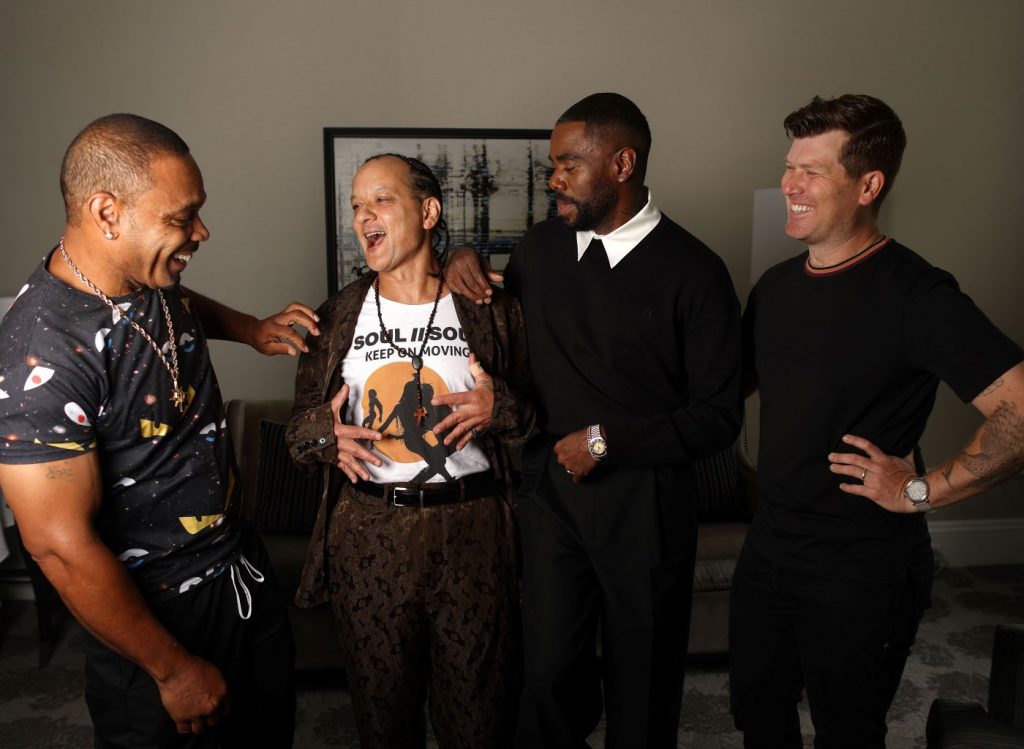Everyone associated with “Sing Sing” has high hopes for a hopeful, move-you-to-tears film set in what many consider one of the most depressing and despairing places to be — the New York correctional institution of the title.
But “Sing Sing” isn’t your cliched film centering on life in prison; it’s more interested in looking at the importance of human connection, the empathy of the arts and the art of empathy. It expresses all that through the actions of inmates as they bond over a quirky production getting staging that’s tied to the real-life Rehabilitation Through the Arts program.
“It’s a film whose setting is a prison, but it’s not about a prison,” sums up Oscar-nominated actor Colman Domingo, its charismatic lead. “We made this film with the faith that people want a story like this.”
Onetime prisoner Clarence Maclin delivers a memorable performance as an inmate who takes part in a prison theater project in “Sing Sing.” (A24 Films)
It was also one, he is quick to point out, that was conceived and made outside of the Hollywood studio system, and might even influence later productions.
Long in the gestation process, “Sing Sing” also stars Bay Area stage actor Sean San Jose, as well as Paul Raci and an impressive lineup of first-time movie actors who used to be incarcerated, including breakout costar Clarence Maclin.
After riding on waves of standing ovations at film festivals and at advance screenings – including an emotional one at the real-life Ossining Correctional Facility, where the film is set (only the exteriors were used in the film) — the A24 release opens Friday in Bay Area theaters.
Maclin proves to be the film’s revelation as swaggering, self-professed “yard bird” Divine Eye who gets tips from stage savvy mentor Divine G (Domingo), who’s been locked up for a crime he didn’t commit. With G’s help, Divine Eye reveals unexpected lightning bolts of talent that then thunder onstage. The gregarious Colman plays a variation of himself and holds out hope that “Sing Sing” heightens awareness about the men held behind cell-block walls and what they have to offer society once they exit those confined walls.
“One of the main things I would like people to take away (from “Sing Sing”) is that people in prison are just people,” Maclin during a promotional tour for the film with Kewdar, Domingo and Sean San Jose in San Francisco — a place Domingo and San Jose know very well.
“They’re human beings and whatever happened to them, they’re alive and that happened already,” Maclin said. “They all have the ability to change, to grow. It just depends on how much we pour into them. How much hope we pour into them. How much inspiration we pour into them. How much trust we lend because a lot of people in prison would love to be trusted and will be able to come back to the community and participate and be constructive.”
Maclin is putting those words into action, not only in front of the camera but in real life, working with at-risk youths.
What made the experience working on “Sing Sing” so special for Domingo (he signed before the script was done) was the collaborative nature of the cast and crew and how willingly everyone was willing to adapt if something didn’t work.
When that happened, “We’re like we have to really go back in the kitchen and figure this out because it feels false,” he said. “And they were like ‘it doesn’t feel right’ or ‘the staging doesn’t feel right.’ We would step up because it was like how everyone owns the film.”
Another pleasure for Domingo came in collaborating again with Sean San Jose, who’s artistic director at Magic Theatre Company and founder of the Campo Santo stage troupe. The two worked together at Theater Rhinoceros in San Francisco in the late ‘90s, and later at Berkeley Rep, San Jose Rep and American Conservatory Theatre.
Domingo and Sean San Jose — who plays Mike Mike, Divine G’s best friend on the inside — share one of “Sing Sing’s” best sequences when their characters reveal a good deal about themselves one night as they talk in side-by-side cells. It was a scene sketched out on paper but then built upon and improvised by the two stage friends — who can identify what the other one wants to accomplish in a second and then play off it as a scene progresses.
“I had never done a shot like that or that long,” said San Jose. “And here’s the trust in the gift of the process. We shot it. Got through it. … And then Colman pulled me aside and said that was good. And because he knows me he said: ‘I know what’s in the chamber. So we’re gonna go one more.’”
What also impressed Domingo and San Jose about the production was how Kewdar and filmmaking partner Clint Bentley drafted what could turn into a template for future indie filmmakers. Their novel financial approach calls for paying everyone in the production — from the lead to the key grip — the same salary while giving everyone equity as well.
“Every single thing about it is brand new and moving, I think the industry is hopefully a new way of being,” Domingo said.
To that point, “Sing Sing” itself is different in what it’s accomplishing, a stark departure from typical cinematic depictions of men in prison.
Maclin avoided viewing films that were similar in theme or setting.
“We don’t watch them. We don’t watch them,” he said. “We don’t see ourselves in them. This doesn’t relate to me.”
Kwedar steered clear of looking at what had been presented onscreen before in order to create something kinetic and distinctive.
“We didn’t visit any previous works from the cannon,” the director of the 2016 border-themed thriller “Transpecos” said. “I don’t think you can even really classify this film as a prison movie or a theater story. It kind of exists on its own.”
Nurturing it into an actual film took time for Kewdar and creative partner Clint Bentley — eight years of processing, shaping, creating and then going back to the proverbial drawing board. Nothing quite stuck to the story wall.
The genesis of “Sing Sing” came about while Kewdar was helping a friend on a short documentary in a maximum security prison in Wichita, Kansas, and while on a tour he spotted a young man incarcerated there raising a rescue dog.
An idea lodged into his brain..
He wondered if there were other programs available like that one within the prison system and then embarked on an internet search. It led him to a 2005 Esquire article about a theater production tied to the RTA program. The article was titled “Sing Sing Follies.”
Bingo.
But there was no narrative spark that fueled the engine from there. That arrived when stage director, playwright and RTA volunteer Brent Buell (portrayed by Oscar nominee Raci) introduced Kewdar and Bentley to Maclin and other alums from the prison system over breakfast six years into the development process. Both were taken by the charisma and presence and how present the men were.
Maclin knew right away that Kewdar would respect his story and tell it well.
“Clint and Greg had this real honest feeling about them,” he explains. “Like they weren’t there to exploit. They weren’t there to treat us like a tax write-off. … A lot of people want to do things for prisoners or for people that they feel are less fortunate than them so they can get a good night’s sleep at night. I didn’t feel that way with Greg and Clint.”
Making the transition from stage to screen took some getting used to, though, for Maclin. Domingo, Kewdar and Raci helped him get those sea legs for a new art form.
“I’m used to this stage and I gotta make sure the guy all the way in the last seat over can hear every word I say. (Domingo, Kewdar and Raci) showed me how to bring it in from that big school.”
Given the hopeful nature of the film, Domingo holds out his own hope that “Sing Sing” — both in the story it has to tell and the way it was made — will inspire.
He realizes that studios “need the lights on in different ways to appeal to the masses” but that there’s an opportunity to “tell these stories” that aren’t getting told.
“We want to tell them in an extraordinary and complex way,” he said. “So if we’re now being beacons of hope in this industry, that’s kind of dope … . We want to keep mining stories that are unique to us.”


